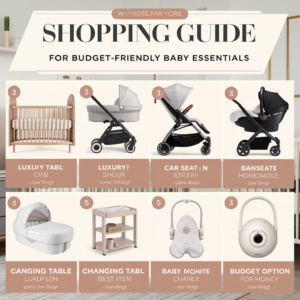A babygirl budget mastery is the art of comprehensively managing all financial aspects related to raising a baby girl, from immediate needs like diapers to long-term considerations such as daycare. It involves strategic planning, smart resource allocation, and continuous adaptation to evolving needs, ensuring financial stability while providing the best care possible for your daughter.
Key Takeaways:
- Effective budgeting covers both short-term and long-term expenses
- Balancing quality and cost is crucial across all spending categories
- Regular budget reviews and adjustments are essential as your baby grows
- Planning for major expenses like daycare requires early consideration
- Utilizing various saving strategies can significantly reduce overall costs
Understanding the Scope of a Babygirl Budget
A comprehensive babygirl budget encompasses all aspects of care, from daily necessities to future planning. It includes immediate needs like diapers and feeding supplies, mid-term requirements such as clothing and gear, and long-term considerations like healthcare and education. Mastering this budget means being prepared for all stages of your baby girl’s early years.
Step-by-Step Guide to Mastering the Babygirl Budget
1. Create a Comprehensive Expense List (Before baby arrives)
- Include all potential expenses from birth through early childhood
- Categorize expenses as immediate, short-term, and long-term
- Research average costs in your area for each category
2. Set Up a Flexible Budgeting System (1-2 months before due date)
- Choose a budgeting method that allows for easy tracking and adjustments
- Consider using budgeting apps or software for real-time monitoring
- Allocate funds to different expense categories based on priority and cost
3. Plan for Diaper Expenses (First year)
- Calculate estimated diaper needs based on average usage
- Compare costs of different diaper options (disposable vs. cloth)
- Look into subscription services or bulk buying for cost savings
4. Budget for Feeding (First year)
- Account for breastfeeding supplies or formula costs
- Plan for the transition to solid foods around 6 months
- Include costs of feeding equipment (bottles, sterilizers, high chairs)
5. Allocate Funds for Clothing (Ongoing)
- Plan for rapid growth in the first year
- Budget for seasonal clothing needs
- Consider second-hand options and clothing swaps
6. Account for Healthcare Costs (Ongoing)
- Review your health insurance coverage for pediatric care
- Budget for regular check-ups and vaccinations
- Set aside funds for unexpected medical expenses
7. Plan for Childcare and Daycare (3-6 months before needed)
- Research different childcare options in your area
- Compare costs of daycare centers, in-home care, and nannies
- Consider flexible spending accounts or dependent care benefits from work
8. Budget for Baby Gear (Before baby arrives and ongoing)
- Prioritize essential items like car seats, strollers, and cribs
- Look for convertible options that grow with your child
- Consider borrowing or buying second-hand for rarely used items
9. Set Up Savings for Future Expenses (As early as possible)
- Start an education fund or 529 plan
- Consider life insurance and estate planning
- Begin building an emergency fund for unexpected expenses
10. Plan for Developmental Needs (Ongoing)
- Budget for age-appropriate toys and books
- Consider costs of classes or activities as your baby grows
- Plan for technology needs in later years
11. Implement Cost-Saving Strategies (Ongoing)
- Use coupons and cashback apps for regular purchases
- Take advantage of sales for bulk buying non-perishables
- Join local parenting groups for item swaps and shared resources
12. Regular Budget Reviews and Adjustments (Monthly)
- Set a monthly date to review your babygirl budget
- Adjust allocations based on changing needs and actual expenses
- Identify areas of overspending and find ways to cut back
Innovative Budgeting Techniques for 2025
- Utilize AI-powered budgeting assistants for personalized financial advice
- Engage with virtual reality simulations to plan for future expenses
- Use blockchain-based savings accounts for long-term financial planning
- Implement smart home technology to monitor and reduce household expenses
- Explore community-based childcare co-ops facilitated by digital platforms
Key Budget Categories to Master
Daily Essentials:
- Diapers and wipes
- Formula or breastfeeding supplies
- Baby food and snacks
Healthcare:
- Insurance premiums and copays
- Medications and first aid supplies
- Wellness visits and vaccinations
Childcare:
- Daycare or nanny expenses
- Occasional babysitting costs
- Early education programs
Clothing and Gear:
- Everyday outfits and sleepwear
- Seasonal clothing and accessories
- Strollers, car seats, and other equipment
Development and Education:
- Books and educational toys
- Classes and activities
- Technology and learning tools
Long-term Planning:
- College savings fund
- Life insurance
- Emergency fund
Frequently Asked Questions
Q: How much should I budget for daycare expenses? A: Daycare costs vary widely but can range from $500 to $2,500 per month. Research local options and consider setting aside 10-20% of your income.
Q: Is it worth investing in expensive baby gear? A: Not always. Focus on quality and safety for essential items like car seats, but many high-end products aren’t necessary for your baby’s well-being.
Q: How can I reduce the cost of formula feeding? A: Consider store brands, buy in bulk, use cashback apps, and sign up for formula company rewards programs for discounts and samples.
Q: Should I start saving for college now? A: Yes, if possible. Even small contributions to a 529 plan or education savings account can grow significantly over time.
Q: How do I balance immediate needs with long-term financial planning? A: Prioritize immediate needs first, then allocate a percentage of your budget to long-term savings. Adjust as your financial situation allows.
Conclusion
Mastering the babygirl budget from diapers to daycare requires careful planning, regular adjustments, and a balance between meeting immediate needs and planning for the future. By creating a comprehensive budget that covers all aspects of your baby girl’s care and development, you can ensure that you’re financially prepared for the journey ahead. Remember that every family’s situation is unique, so your budget should reflect your specific circumstances and priorities. Stay flexible, take advantage of cost-saving opportunities, and don’t forget to enjoy the precious moments with your little one. With diligent planning and smart financial management, you can provide the best for your baby girl while maintaining financial stability.
Would you like me to continue with the next article in the updated list?



